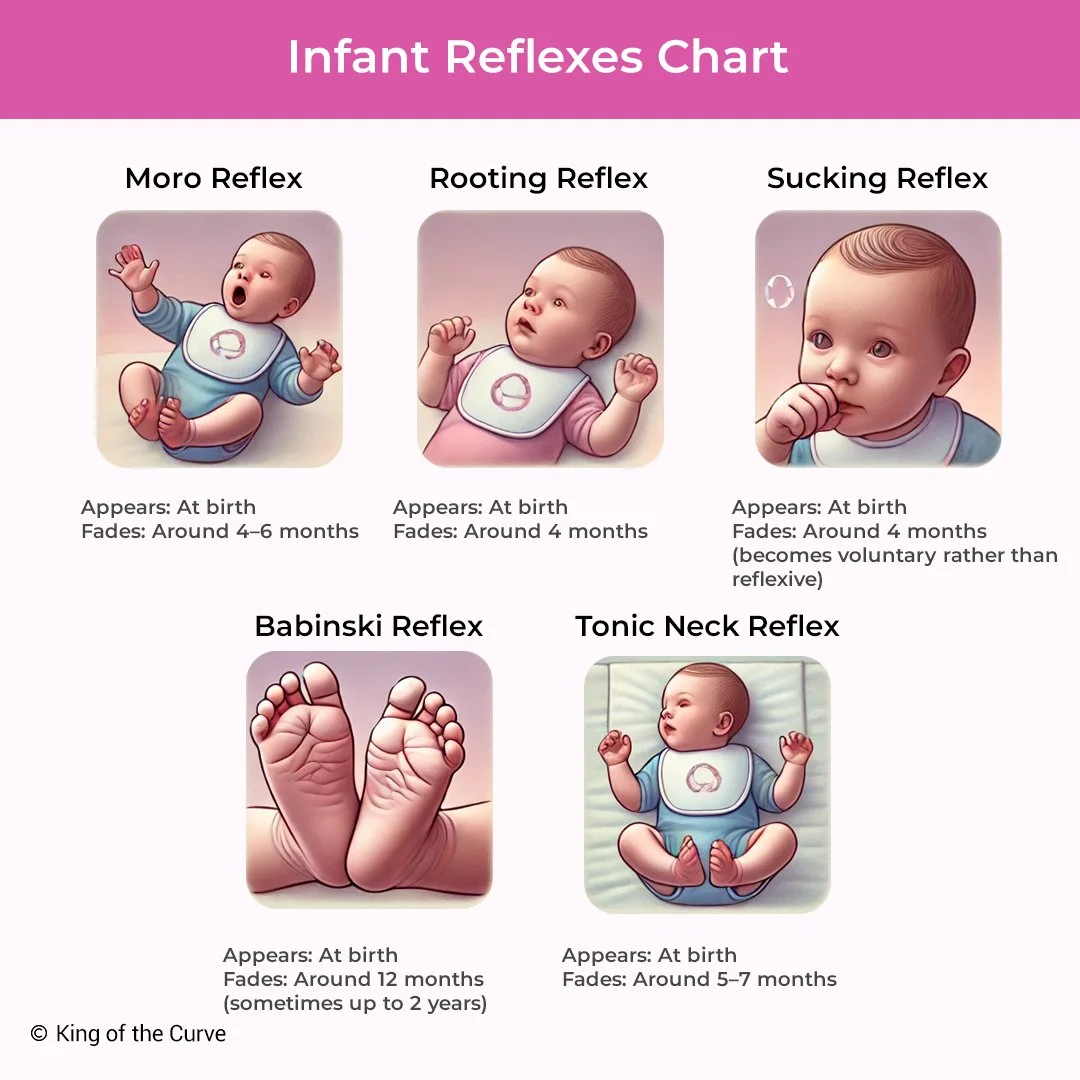Infant Reflexes: Understanding Your Baby’s Natural Responses
Newborns are born with a set of automatic, involuntary movements known as infant reflexes. These reflexes are essential for survival, development, and early interactions with the world. Over time, these reflexes fade as babies gain more control over their movements. Let’s explore the five key infant reflexes, their purpose, and when they typically disappear.
1. Moro Reflex (Startle Reflex)
Appears: At birth
Fades: Around 4–6 months
The Moro reflex occurs when a baby is startled by a sudden movement or loud noise. The baby will instinctively throw their arms out, then bring them back in, often accompanied by crying. This reflex helps newborns respond to potential dangers.
2. Rooting Reflex
Appears: At birth
Fades: Around 4 months
The rooting reflex helps babies find their food source. When you stroke your baby’s cheek, they will turn their head in that direction, ready to suck. This reflex is crucial for early breastfeeding and bottle-feeding.
3. Sucking Reflex
Appears: At birth
Fades: Around 4 months (becomes voluntary rather than reflexive)
The sucking reflex is essential for feeding. When an object (like a nipple or pacifier) touches the roof of a baby’s mouth, they instinctively begin to suck. Over time, this reflex becomes a voluntary action as the baby learns to coordinate sucking with swallowing.
4. Babinski Reflex
Appears: At birth
Fades: Around 12 months (sometimes up to 2 years)
The Babinski reflex is seen when you stroke the sole of a baby’s foot, and their toes fan out. This is a normal neurological response in infants but disappears as the nervous system matures.
5. Tonic Neck Reflex (Fencer’s Reflex)
Appears: At birth
Fades: Around 5–7 months
When a baby turns their head to one side, the arm on that side extends while the opposite arm bends. This "fencing position" reflex is believed to help develop hand-eye coordination and prepare the baby for voluntary reaching.
This topic is important for MCAT students because it directly relates to foundational concepts in biology and psychology, both of which are tested on the Psychological, Social, and Biological Foundations of Behavior (PSBB) section of the exam. Here’s why understanding infant reflexes is crucial for MCAT preparation:
1. Neurological Development & The Brain
Infant reflexes are primitive neurological responses, controlled by the central nervous system (CNS), particularly the brainstem and spinal cord.
Questions on the MCAT often test neurological pathways, brain regions, and their roles in motor function.
2. Developmental Psychology & Behavioral Science
Infant reflexes are part of Piaget’s stages of cognitive development and are relevant in developmental psychology.
Understanding reflexes helps explain nature vs. nurture in early motor skill development, a common MCAT psychology/sociology concept.
3. Clinical & Medical Applications
Reflex testing is used in neurological exams to assess brain and nerve function in infants.
Abnormal reflexes can indicate neuromuscular disorders or conditions like cerebral palsy.
MCAT passages often discuss clinical applications, requiring students to interpret findings.
4. Integration with Other MCAT Topics
Neurotransmission: Reflexes are mediated by sensory neurons, interneurons, and motor neurons.
Physiology: Reflex arcs demonstrate afferent and efferent pathways, helping students understand autonomic vs. somatic reflexes.
Research & Experimentation: The MCAT frequently presents research-based questions on infant development and neuroplasticity.
5. High-Yield MCAT Question Scenarios
A question might describe an infant failing to show the Babinski reflex and ask which part of the nervous system is likely damaged.
A passage could discuss developmental milestones and test knowledge on how reflexes transition into voluntary movements.
An experimental setup could examine how brain injury affects reflex persistence.
Expand Your Knowledge with KOTC
At King of the Curve, we’re passionate about long-term learning, making results effortless and rewarding for over 100,000 downloads of our resources. Our unique features—like the Adaptive Q-Bank, stunning visuals, multiplayer modes, timed practice, and daily questions—help you master science concepts, including mental health, for exams like the MCAT. Check out our KOTC classroom, earn Curve Coins through gamification, and explore our custom homepage at mcat.kingofthecurve.org for more resources.
For a more comprehensive understanding, visit mcat.kingofthecurve.org. Access over 1000+ illustrations summarizing core concepts essential for MCAT success.
Frequently Asked Questions (FAQs)
-
Aim for 4-6 focused hours, ensuring you incorporate breaks to avoid burnout.
-
Practice mindfulness techniques, take practice exams under realistic conditions, and maintain a balanced lifestyle.
-
Set short-term goals, seek support from mentors, and reward yourself for small achievements.
-
Regular exercise improves focus, reduces stress, and enhances overall mental clarity.
-
KOTC offers personalized learning tools, gamification features, and adaptive question banks to help students stay on track without burnout.


